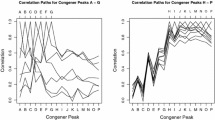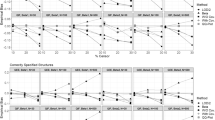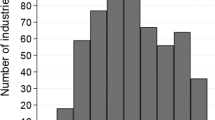Abstract
Assessing assay variability for field samples in environmental research is challenging, since a quantitative assay is typically constrained by a lower limit of detection. The purpose of this paper is to compare three parametric models for assessing assay variability using duplicate data subject to heavy left-censoring. Efron information criterion (EIC) and Bayesian information criterion (BIC) are used to aid in model selections. Distributional parameter estimates are obtained using maximum likelihood estimation for bivariate lognormal, bivariate zero-inflated lognormal, and bivariate 3-component mixture models. We illustrate a practical application using duplicate pesticide data from the Community Participatory Approach to Measuring Farmworker Pesticide Exposure (PACE3) study. Furthermore, a simulation study is conducted to empirically evaluate the performance of the three models. The results from PACE3 indicate that the bivariate zero-inflated lognormal model is fairly competitive based on EIC or BIC. Further, total variability for the lognormal component can be decomposed into between-subject and within-subject variance based on this model. Assay variability estimates such as within-subject coefficient variation, minimum detectable change, and probability of \(k\)-fold difference can be easily derived under the bivariate zero-inflated lognormal model. Additionally, the assay variability is rather large for the PACE3 data. Therefore, apparent longitudinal change in pesticide exposure should be examined cautiously in the context of substantial assay variability.
Supplementary materials accompanying this paper appear online.




Similar content being viewed by others
References
Arcury TA, Grzywacz JG, Chen H, Vallejos QM, Galván L, Whalley LE, et al. 2009. Variation across the agricultural season in organophosphorus pesticide urinary metabolite levels for Latino farmworkers in eastern North Carolina: project design and descriptive results. American Journal of Industrial Medicine 52:539–550.
Arcury TA, Grzywacz JG, Talton JW, Chen H, Vallejos QM, Galván L, Barr DB, Quandt SA. 2010. Repeated pesticide exposure among North Carolina migrant and seasonal farmworkers. American Journal of Industrial Medicine 53:802–813.
Barnhart HX, Song J, and Lyles RH. 2005. Assay validation for left-censored data. Statistics in Medicine 24:3347–3360.
Berk KN and Lachenbruch PA. 2002. Repeated measures with zeroes. Statistical Methods in Medical Research 11:303–316.
Bland JM and Altman DG. 1986. Statistical methods for assessing agreement between two methods of clinical measurement. Lancet 5:307–310.
——— 1996. Measurement error. British Medical Journal 312:1654.
Chinn S. 1990. The assessment of methods of measurement. Statistics in Medicine 9:351–362.
Chow S and Tse S. 1990. A related problem in bioavailability/bioequivalence studies - estimation of the intrasubject variability with a common CV. Biometrical Journal 32(5): 597–607.
Chu H, Kensler TW, and Muñoz A. 2005. Assessing the effect of interventions in the context of mixture distributions with detection limits. Statistics in Medicine 24:2053–2067.
Chu H, Nie L, and Zhu M. 2008. On estimation of bivariate biomarkers with known detection limits. Environmetrics 19:301–317.
Donoghue D, Physiotherapy Research and Older People (PROP) group, and Stokes EK. 2009. How much change is true change? The minimum detectable change of the Berg Balance Scale in elderly people. Journal of Rehabilitation Medicine 41:343–346.
Euser AM, Dekker FW, 2008. A practical approach to Bland-Altman plots and variation of coefficients for log transformed variables. Journal of Clinical Epidemiology 61:978-982.
Helsel DR. 2005. Nondetections and Data Analysis: Statistics for Censored Environmental Data. Hoboken, NJ: John Wiley and Sons.
Jacqmin-Gadda H, Thiébaut R, Chêne G, Commenges D. 2000. Analysis of left-censored longitudinal data with application to viral load in HIV infection. Biostatistics 1(4):355–368.
Lyles RH, Fan D, and Chuachoowong R. 2001a. Correlation coefficient estimation involving a left censored laboratory assay variables. Statistics in Medicine 20:2921–2933.
Lyles RH, Williams JK, and Chuachoowong R. 2001b. Correlating two viral load assays with known detection limits. Biometrics 57:1238–1244.
Moulton LH, Halsey NA. 1995. A mixture model with detection limits for regression analyses of antibody response to vaccine. Biometrics 51:1570–1578.
Reed GF, Lynn F, and Meade BD. 2002. Use of coefficient of variation in assessing variability of quantitative assays. Clinical and Diagnostic Laboratory Immunology 9(6):1235–1239.
Rosner B. 2006. Fundamentals of Biostatistics. 6th ed. Belmont CA:Duxbury.
Self SG and Liang K-Y. 1987. Estimators and likelihood ratio tests under nonstandard conditions. Journal of the American Statistical Association 82: 605–10.
Quan H and Shih WJ. 1996. Assessing reproducibility by the within-subject coefficient of variation with random effects models. Biometrics 52:1195–1203.
Taylor DJ, Kupper LL, Rappaport SM, Lyles RH. 2001. A mixture for occupational exposure mean testing with a limit of detection. Biometrics 57:681–688.
Thiébaut R, Jacqmin-Gadda H. 2004. Mixed models for longitudinal left-censored repeated measures. Computer Methods and Programs in Biomedicine 74:255–260.
U.S. Environmental Protection Agency. 1982. Definition and procedure for the determination of the method detection limit; Code of Federal Regulations 40, Part 136, Appendix B: 565–567.
, , , 2006. When to use agreement versus reliability measures. Journalof Clinical Epidemiology 59:1033-1039.
Westgard JO, Quam EF, Barry PL. 1994a. Establishing and evaluating QC acceptability criteria. MLO: medical laboratory observer 26(2): 22–26.
Westgard JO, Seehafer JJ, Barry PL. 1994b. Allowable imprecision for laboratory tests based on clinical and analytical test outcome criteria. Clinical chemistry 40(10): 1909–1914.
Acknowledgments
This research is supported by Grant R01 ES 008739 from the National Institute of Environmental Health Sciences. We thank R. Lyles for providing a sample SAS program. We also thank the associate editor and the three anonymous reviewers for their constructive comments that led to a much improved manuscript.
Author information
Authors and Affiliations
Corresponding author
Electronic supplementary material
Below is the link to the electronic supplementary material.
Rights and permissions
About this article
Cite this article
Chen, H., Quandt, S.A., Barr, D.B. et al. Assessing Assay Variability of Pesticide Metabolites in the Presence of Heavy Left-Censoring. JABES 20, 65–82 (2015). https://doi.org/10.1007/s13253-015-0196-3
Received:
Accepted:
Published:
Issue Date:
DOI: https://doi.org/10.1007/s13253-015-0196-3




